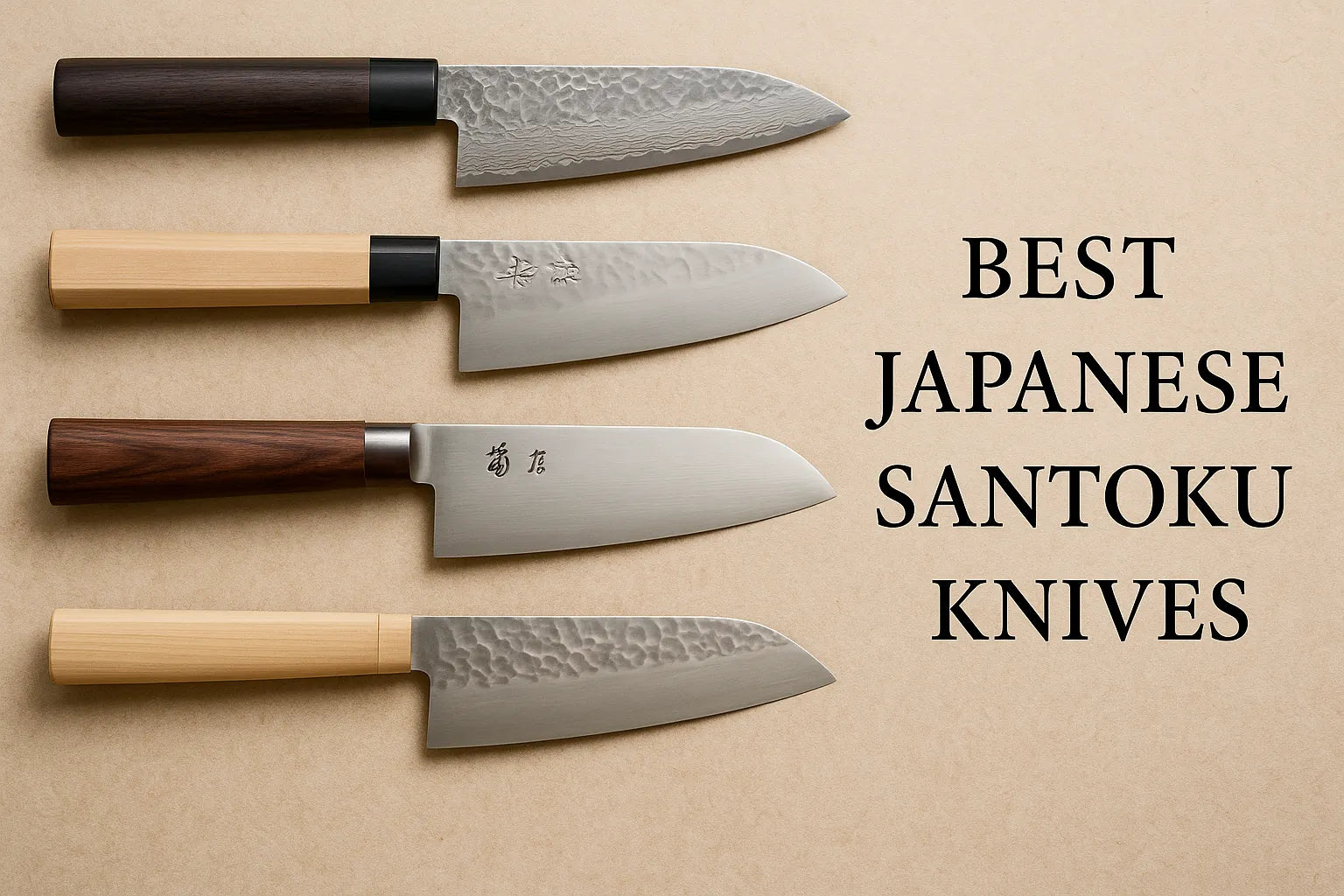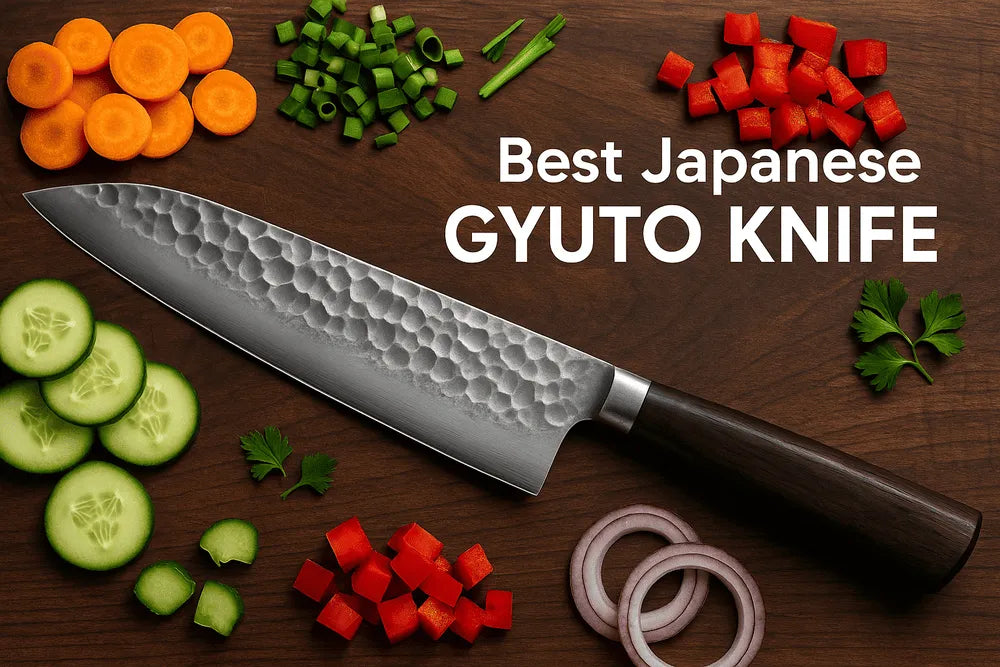Carbon steel knives age like fine whisky — sharp, strong, and full of character. But only if you know how to care for a carbon steel knife. In this guide, you’ll learn how to clean a carbon steel knife, prevent rust, and keep your blade performing beautifully for years. In other words, everything about carbon steel knife care is in one article.
Why Carbon Steel Knives Need Special Care
If you’ve ever owned a carbon steel knife, you’ve probably noticed two things right away:
- It gets razor sharp faster than anything else.
- It also rusts just as fast if you’re not careful.
That’s both the beauty and the challenge of carbon steel.
Carbon steel is a living material. Unlike stainless steel, it reacts to air, moisture, and even the food you cut. Over time, it forms a natural gray-blue patina, a kind of armor that protects it from rust. The more you use it, the stronger and more beautiful that layer becomes.
That’s why caring for a carbon steel knife isn’t just about maintenance. It’s about building a relationship with your tool. You’ll start to notice how it changes with use, how it feels sharper or smoother depending on your routine. Once you get into that rhythm — cleaning, drying, oiling — you’ll realize something important:
👉 The sharper your knife, the more it reflects your care.
If you’ve ever wondered how it compares to stainless steel in sharpness, feel, and maintenance, check out our guide on carbon steel vs stainless steel knives to see which one truly fits your cooking style.

How to Clean and Care for a Carbon Steel Knife (Step-by-Step)
Caring for a carbon steel knife doesn’t take long. It just takes consistency. Think of it like brushing your teeth: simple steps, done every time, make all the difference.
After years of testing knives in both professional kitchens and home environments, I’ve learned that how you clean your knife matters as much as how you use it. Here’s exactly what I recommend.
1. Rinse Right After Cutting
Never leave your knife sitting on the cutting board while you eat or chat.
Food acids, especially from citrus, onions, or tomatoes, can etch and stain the blade within minutes.
Proper carbon steel knife maintenance starts with simple cleaning habits. Just rinse it under warm running water. You don’t need fancy solutions, just water and a bit of attention.

2. Use Mild Soap (If Needed)
There’s a myth that you can’t use soap on carbon steel. That’s not true — you just have to use it correctly.
A small drop of mild dish soap and a soft sponge will do. Avoid harsh detergents or scrub pads that scratch the blade.
Gently wipe both sides, especially near the spine and the handle junction — spots that trap moisture.
3. Dry Immediately — Completely
This step is non-negotiable. When taking care of a carbon steel knife, always dry it immediately after washing.
The second you’re done washing, grab a clean towel and dry the knife from spine to edge (never the other way around for safety).
Make sure no water remains near the handle or the bolster. That’s where rust loves to hide.
If you’re in a humid place (like much of Asia), I often recommend waving the knife in the air for a few seconds after towel drying. It helps evaporate leftover moisture.

4. Oil Lightly - Care for a Carbon Steel Knife
Once dry, apply a tiny drop of food-safe oil — mineral oil, camellia oil, or even neutral cooking oil — on both sides.
Rub it gently with a soft cloth.
This thin layer keeps moisture and air away from the blade, forming an invisible shield against rust.
For home cooks, doing this once a day or every few uses is enough.
Remember, how to take care of a carbon steel knife isn’t complicated — it’s about consistency. Clean, dry, and oil it regularly, and your knife will last decades.

5. Store It Right
Don’t throw it into a drawer.
Use a wooden sheath, knife block, or magnetic strip — anything that keeps the blade dry and safe.
Avoid leather covers for long-term storage. Leather holds moisture, which can rust even a well-oiled knife.
💡 Pro Tip:
If you ever notice small dark spots after washing, don’t panic. That’s likely the start of a patina, not rust. It’s actually a good sign your knife is forming its natural protective layer.
These steps also apply to high carbon steel knife care, since the metal reacts the same way.
How to Prevent Rust and Build a Natural Patina
1. Keep It Dry (Always)
Water is the fastest way to kill carbon steel.
Even a few drops left on the blade can cause orange rust overnight.
So after each use, make “dry completely” your golden rule.
If you live in a humid area, a light coat of oil after every wash is the simplest, most reliable protection.

2. Embrace the Patina
Many beginners try to scrub it off — don’t.
That soft gray-blue layer actually blocks oxygen from touching the steel.
The more you use your knife, especially on proteins or vegetables like onions, the richer the patina becomes.
If you want to speed it up naturally, try cutting cooked meat or wiping the blade with vinegar for a few minutes — but never force it with chemicals.
3. Don’t Fear Discoloration
At first, you might see uneven shades on the blade. That’s totally normal.
Patina forms irregularly, depending on how you use the knife. Over time, it evens out into a soft, satin-like finish that both looks elegant and resists rust.

4. Watch Out for Orange or Rough Spots
Gray or blue = patina.
Orange or flaky = rust.
If you spot early rust, gently rub it with a wine cork and baking soda paste or a bit of rust eraser. Then clean, dry, and oil right away.
5. Use It Often
Funny enough, the knives that rust the most are the ones that sit unused.
Regular use builds the patina faster and keeps the surface “active,” making it more resistant to oxidation.
A well-used carbon steel knife doesn’t just stay sharp. It looks alive.
💡 Pro Tip:
If you’re new to carbon steel, don’t chase perfection.
A knife with a bit of character — slight discoloration, minor marks — is often the one that performs best.
Noticed a bit of orange rust starting to form? Check out how to remove rust from carbon steel knife to learn how to clean it up safely.

How to Store Carbon Steel Knives the Right Way
Once you’ve cleaned and oiled your knife, the next question is simple: where do you keep it?
Because here’s the thing: you can follow every care step perfectly, and still end up with rust if your storage spot traps moisture. After a decade of handling Japanese knives, I can tell you — storage is just as important as washing.
Let’s go over what actually works:
-
Use a Magnetic Strip (Best for Airflow): A magnetic wall strip keeps your knife aired out, prevents moisture buildup, and avoids scratches from other utensils.
-
Knife Blocks Work — If You Keep Them Clean: Wooden knife blocks are fine as long as your knives are fully dry and you clean the slots regularly.
-
Blade Guards or Saya Covers: Use wood, plastic, or silicone guards to protect the edge — avoid leather sheaths since they trap moisture and can corrode steel.
-
Avoid Drawers Without Protection: Never toss a knife unprotected into a drawer — it dulls the edge, risks rust, and can be dangerous; use edge guards or inserts instead.
💡 Pro Tip: Keep a small dehumidifier or silica gel pack near your knife rack to control humidity, especially during rainy seasons.

Final Thoughts
Caring for a carbon steel knife isn’t just maintenance. It’s mindfulness. Every time you wipe it dry or apply a few drops of oil, you’re not just preserving metal. You’re honoring the hands that forged it — and the meals it helps you create.
These knives are living tools. They darken, change, and develop a patina that’s completely unique to you. That’s the beauty of carbon steel. It becomes a reflection of your journey in the kitchen.
Take care of it with respect, and it’ll reward you with a lifetime of sharpness, precision, and quiet pride every time you slice.
FAQs About Carbon Steel Knife Care
-
Yes — regularly. Carbon steel reacts easily to air and moisture, so oiling creates a thin barrier that prevents rust. You don’t need to overdo it — a few drops after cleaning or once every few uses is perfect. Think of oiling as sunscreen for your knife: it keeps the surface protected and glowing.
-
If cared for properly — a lifetime, or even longer. I’ve seen Japanese carbon steel knives passed down for generations. As long as you clean, dry, and sharpen it with respect, the blade will easily outlive you. The steel doesn’t wear out; it only reflects how well you treat it.
-
The safest and most popular choices are food-grade mineral oil and camellia oil. Both are odorless, non-toxic, and don’t go rancid. If you’re in a pinch, you can also use a drop of neutral cooking oil (like canola or grapeseed), but avoid thick or flavored oils.
-
You can, but it’s not ideal. Olive oil can go rancid over time, leaving a sticky or sour-smelling residue on your blade. If you must use it, clean and reapply often — but mineral or camellia oil will keep your knife much cleaner and safer in the long run.



